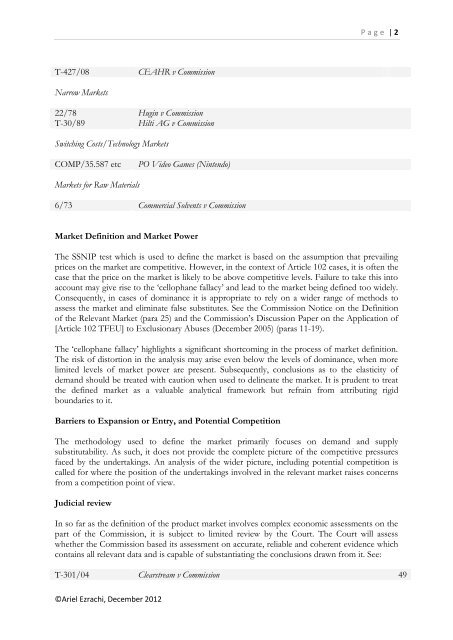EU Competition Law and Policy - compal
EU Competition Law and Policy - compal
EU Competition Law and Policy - compal
Create successful ePaper yourself
Turn your PDF publications into a flip-book with our unique Google optimized e-Paper software.
T-427/08 CEAHR v Commission<br />
Narrow Markets<br />
22/78 Hugin v Commission<br />
T-30/89 Hilti AG v Commission<br />
Switching Costs/Technology Markets<br />
COMP/35.587 etc PO Video Games (Nintendo)<br />
Markets for Raw Materials<br />
6/73 Commercial Solvents v Commission<br />
Market Definition <strong>and</strong> Market Power<br />
©Ariel Ezrachi, December 2012<br />
P a g e | 2<br />
The SSNIP test which is used to define the market is based on the assumption that prevailing<br />
prices on the market are competitive. However, in the context of Article 102 cases, it is often the<br />
case that the price on the market is likely to be above competitive levels. Failure to take this into<br />
account may give rise to the ‘cellophane fallacy’ <strong>and</strong> lead to the market being defined too widely.<br />
Consequently, in cases of dominance it is appropriate to rely on a wider range of methods to<br />
assess the market <strong>and</strong> eliminate false substitutes. See the Commission Notice on the Definition<br />
of the Relevant Market (para 25) <strong>and</strong> the Commission’s Discussion Paper on the Application of<br />
[Article 102 TF<strong>EU</strong>] to Exclusionary Abuses (December 2005) (paras 11-19).<br />
The ‘cellophane fallacy’ highlights a significant shortcoming in the process of market definition.<br />
The risk of distortion in the analysis may arise even below the levels of dominance, when more<br />
limited levels of market power are present. Subsequently, conclusions as to the elasticity of<br />
dem<strong>and</strong> should be treated with caution when used to delineate the market. It is prudent to treat<br />
the defined market as a valuable analytical framework but refrain from attributing rigid<br />
boundaries to it.<br />
Barriers to Expansion or Entry, <strong>and</strong> Potential <strong>Competition</strong><br />
The methodology used to define the market primarily focuses on dem<strong>and</strong> <strong>and</strong> supply<br />
substitutability. As such, it does not provide the complete picture of the competitive pressures<br />
faced by the undertakings. An analysis of the wider picture, including potential competition is<br />
called for where the position of the undertakings involved in the relevant market raises concerns<br />
from a competition point of view.<br />
Judicial review<br />
In so far as the definition of the product market involves complex economic assessments on the<br />
part of the Commission, it is subject to limited review by the Court. The Court will assess<br />
whether the Commission based its assessment on accurate, reliable <strong>and</strong> coherent evidence which<br />
contains all relevant data <strong>and</strong> is capable of substantiating the conclusions drawn from it. See:<br />
T-301/04 Clearstream v Commission 49



